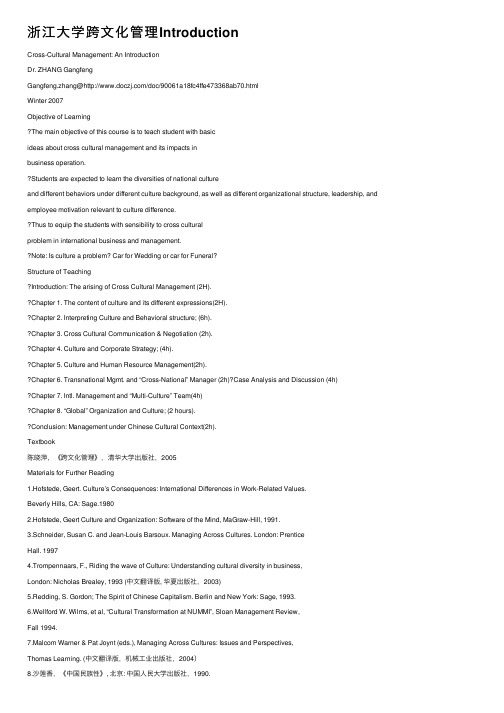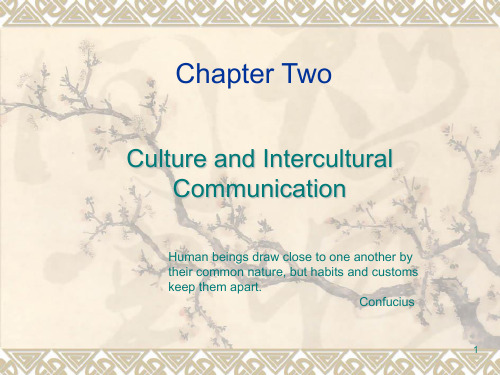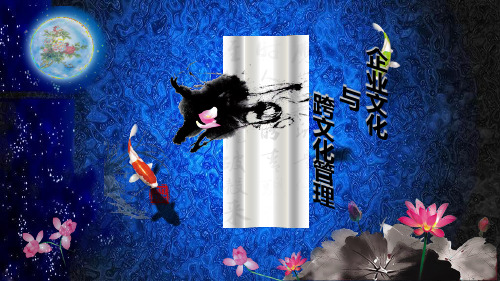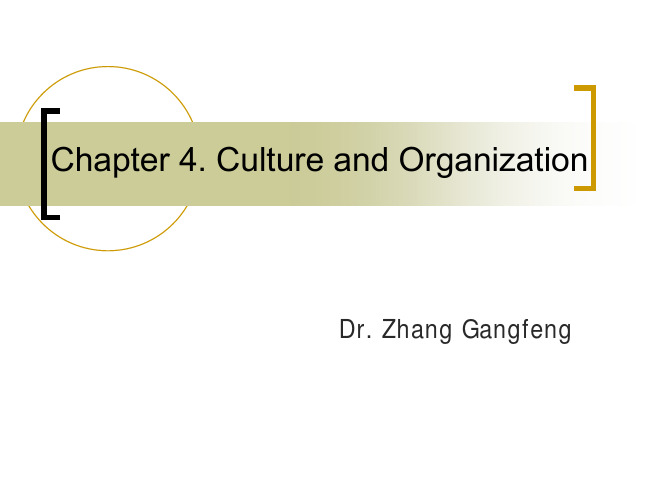浙江大学跨文化管理张刚峰老师课件 Chapter_5_Culture_and_Strategy
第五章 Managing Across Cultures 跨文化管理 国际企业与跨文化管理课件

Strategic Predispositions 战略倾向
Four distinct predispositions toward doing things in a particular way: 以特定方式行事的四种不同倾向: 1. Ethnocentric 母国中心倾向 2. Polycentric 多元中心倾向 3. Regio-centric 地区中心倾向 4. Geocentric 全球中心倾向
– 一种以母国的价值观和兴趣来指导战略决策的国家 主义的管理哲学。
5-4
Strategic Predispositions 战略倾向
• Polycentric predisposition 多元中心倾向
– A philosophy of management whereby strategic decisions are tailored to suit the cultures of the countries where the MNC operates.
– 一种试图整合一个全球体系来进行决策的管理哲学。
5-7
Orientation of an MNC 跨国公司的战略倾向
5-8
Meeting the Challenge 迎接挑战
• The Globalization Imperative: • 全球化规则:
– Belief that one worldwide approach to doing business is key to efficiency and effectiveness. 深信用一种通用方法在世界范围内做生意是取得效率和效果的关键。
5-3
Strategic Predispositions 战略倾向
跨文化管理技巧培训ppt

建立信任与尊重
总结:在跨文化沟通中,建立信任和 尊重是促进有效沟通的重要前提。
VS
建立信任需要双方在沟通过程中展现 真诚、透明和可靠性。尊重则是要尊 重对方的观点、文化和背景差异。通 过建立信任和尊重,可以减少沟通障 碍,增强合作效果,并促进长期关系 的建立。
01
跨文化团队建设与 管理
多元化团队的优点
02
不同文化对沉默、面部表情、肢 体语言等非语言沟通方式的解读 也存在差异,需要特别注意。
工作习惯和风格的差异
不同文化对工作态度、工作方式和时 间管理等方面存在差异,例如某些文 化可能更注重细节和精确度,而其他 文化可能更加注重灵活性和创新。
不同文化在决策方式、风险承担和变 革态度等方面也存在差异,需要理解 和尊重彼此的文化背景。
寻求共识
在处理文化冲突时,积极寻求各方都能接受的解决方案,达成共 识和妥协。
感谢观看
THANKS
THE FIRST LESSON OF THE SCHOOL YEAR
跨文化管理技巧培训
THE FIRST LESSON OF THE SCHOOL YEAR
汇报人:可编辑
2023-12-23
目录CONTENTS
• 跨文化管理概述 • 文化差异识别与理解 • 跨文化沟通技巧 • 跨文化团队建设与管理 • 跨文化谈判技巧 • 跨文化领导力发展
01
跨文化管理ห้องสมุดไป่ตู้述
定义与特点
01
跨文化谈判技巧
了解对方的文化背景与谈判风格
了解不同国家和地区的文化特点 、价值观和行为规范,以便更好 地理解和适应对方的谈判风格。
了解对方谈判团队成员的背景和 角色,以便更好地与他们沟通和
浙江大学跨文化管理Introduction

浙江⼤学跨⽂化管理IntroductionCross-Cultural Management: An IntroductionDr. ZHANG GangfengGangfeng.zhang@/doc/90061a18fc4ffe473368ab70.htmlWinter 2007Objective of LearningThe main objective of this course is to teach student with basicideas about cross cultural management and its impacts inbusiness operation.Students are expected to learn the diversities of national cultureand different behaviors under different culture background, as well as different organizational structure, leadership, and employee motivation relevant to culture difference.Thus to equip the students with sensibility to cross culturalproblem in international business and management.Note: Is culture a problem Car for Wedding or car for FuneralStructure of TeachingIntroduction: The arising of Cross Cultural Management (2H).Chapter 1. The content of culture and its different expressions(2H).Chapter 2. Interpreting Culture and Behavioral structure; (6h).Chapter 3. Cross Cultural Communication & Negotiation (2h).Chapter 4. Culture and Corporate Strategy; (4h).Chapter 5. Culture and Human Resource Management(2h).Chapter 6. Transnational Mgmt. and “Cross-National” Manager (2h)Case Analysis and Discussion (4h)Chapter 7. Intl. Management and “Multi-Culture” Team(4h)Chapter 8. “Global” Organization and Culture; (2 hours).Conclusion: Management under Chinese Cultural Context(2h).Textbook陈晓萍,《跨⽂化管理》,清华⼤学出版社,2005Materials for Further Reading1.Hofstede, Geert. Culture’s Consequences: International Differences in Work-Related Values.Beverly Hills, CA: Sage.19802.Hofstede, Geert Culture and Organization: Software of the Mind, MaGraw-Hill, 1991.3.Schneider, Susan C. and Jean-Louis Barsoux. Managing Across Cultures. London: PrenticeHall. 19974.Trompennaars, F., Riding the wave of Culture: Understanding cultural diversity in business,London: Nicholas Brealey, 1993 (中⽂翻译版, 华夏出版社,2003)5.Redding, S. Gordon; The Spirit of Chinese Capitalism. Berlin and New York: Sage, 1993.6.Wellford W. Wilms, et al, “Cultural Transformation at NUMMI”, Sloan Management Review,Fall 1994.7.Malcom Warner & Pat Joynt (eds.), Managing Across Cultures: Issues and Perspectives,Thomas Learning. (中⽂翻译版,机械⼯业出版社,2004)8.沙莲⾹,《中国民族性》, 北京: 中国⼈民⼤学出版社,1990.9.李泽厚, 《中国古代思想史》,北京: ⼈民出版社,198510.孙隆基,《中国⽂化的深层结构》,⼴西师范⼤学出版社,200411.范徵,《跨⽂化管理:全球化于地⽅化的平衡》;上海外语教育出版社,2004Evaluation of the studyThe evaluation components for this course are asfollows:Case Assignment & discussion 20%Individual Participation20%Final Exam60%Total100%The rising ofCross Cultural managementDiscovery of Culture-based ManagementUntil the 1970s it was generally assumed thatmanagement was much the same around the world.This idea may be supported by the following argument:Management for profit and …one best way?Company will be constrained in their pursuit of efficiency and cost saving.Technology is the same worldwide and it have s homogenizing effect.The effect of OB as a subject is to make us aware of the universal similarity of human behavior in organization.The idea of homogeneity of management got a furtherboost from Convergence (趋同)Theory.The essence of convergence theory is thatindustrialization, having its own laws and dynamics, will naturally transcend (超越)national differences.Discovery of Cultural difference in managementIn 1977, Israeli professor in INSEAD Theodore Weinshallcompiled a set of readings under the title of “Culture andManagement” .In 1979, Philip Harris & Robert Moran published “ManagingCultural Differences: Leadership strategies for a New World of Business”.The success of Japanese companies caused awareness ofmanagerial differences in different countries.When MBO (Management by Objective) was introduced intoEurope, it encountered huge problems in Germany and France.LEST’s salary hierarchy studyLEST(Laboratoire d?Economie et de Sociologie du Travail)did two studies on salary hierarchy inFrance and West Germany, It was found that the gap between the highest paid and the lowest paid was bigger in France than in Germany. LEST’s further studyFrench GermanMany levels in the hierarchy Emphasis on managementStrong demarcation(区分)lines between grades of worker High proportion of production workersQualifications rule OK Vorsprung durch technik(advantage through technique)France GermanyEducation (elite)Training (professional) Hierarchy FunctionBureaucracy Skills Administration…Technik?André Laurent’s Study in 1980sPositive Responses …Most organizationswould be better off ifconflict could beeliminated for ever.?…It is important for a manager to haveat hand precise answers to most ofthe questions that his subordinatesmay raise about their work.?Sweden4%10% USA6%18% UK13%27% Germany16%46% Holland17%17% Switzerland18%38% Denmark19%23% France24%53% Belgium27%44% Italy41%66%Age of globalization calls for Cross culturalmanagementSince 1980s, cross border investment has beenincreased dramatically. More and more managersencounter difficulty in operating abroad successfully.Therefore people come to realize the importance ofcross cultural management.Since the middle of 1980s, Since the mid-80s thegrowth rate of FDI has been around four times higherthan that of global GNP growth. In 1973, global FDI flow is about 21.5 billion USD, but it reached to 735 billion in 2001.With the popularity of international trade, cross culturalcommunication or negotiation also becomes important, or even critical to the success of business operation.Why we need to study Cross Cultural Management?The importance of Cross CulturalManagementInternational Trade and FDILatest Development of world tradeGlobal gross domestic production (GDP) growth accelerated to3.7% in 2006, the second best performance since 2000.The dollar value of world merchandise exports increased by 15%to $11.76 trillion in 2006. Commercial services exports were up by an estimated 11% and reached $2.71 trillion in 2006. Developing countries share of world merchandise exportsreached an all time record of 36%. The 0.9% share for least-developed countries was also a record, the highest level since 1980,Chinas trade growth continued to outstrip other major traders.China?s merchandise exports grew by 27%. In the second half of 2006, its merchandise exports started to exceed those of the United States, but for the whole year US exports still exceeded those of China.Global Capital FlowsPortfolio and other short-term capital flows now total more than 2trillion US dollars, approximately three times those of the 1980s.The daily turnover in foreign exchange markets has increased,from an average of 10-20 bln USD in 1970s, to about 200 billion in the mid-80s, to well over 1.2 trillion in 1996, and 1.5 trillion in 1998. International bank lending grew from 265 billion USD in 1975 to4.2 trillion USD in 1994.Global FDI flows remained almost flat in 2003, at the five-yearlow of approximately $600 billion recorded in 2002.Foreign Direct InvestmentIn 1973, global FDI was 21.5 billion US dollars, and in 1997 itexpanded to almost 400 billion US dollars, which represents an annual average growth rate of almost 13%.FDI stocks jumped from 165 billion US dollars at the end of1973 to 3205 billion US dollars in 1996 (WTO 1998; UNDP 1999).Since the mid-80s the growth rate of FDI has been aroundfour times higher than that of global GNP growth.FDI flows collapsed after the burst of the IT bubble and thestock market crashes in 2001. Due to the steep fall of FDIflows, the ratio of FDI flows to gross fixed investmentdecreased to 11%, after a fivefold increase between the early 1990s(4%) and 2000(20%). 1987-2003 Global FDI Flow(unit:billion USD)Year1987-921993199419951996199719982000200120022003 YearAverageGlobal173.52192353293594646441492735600600 FDI。
跨文化交际第二章文化与跨文化交际PPT

Learning Culture through Proverbs
❖ "Loud thunder brings little rain." ❖ "A man's tongue is his sword." ❖ "A single arrow is easily broken, but not
in a bunch." ❖ "He who stirs another's porridge often
Generation. ❖ Culture Is Based on Symbols. ❖ Culture Is Subject to Change. ❖ Culture Is an Integrated System. ❖ Culture Is Ethnocentric.
8
Culture Is Not Innate; It Is Learned.
3
Culture
❖ Some people in many parts of the world put dogs in their ovens, but people in the United States put them on their couches and beds. Why?
❖ Some people in Iran pray five times each day while sitting on the floor, but some people in Las Vegas sit up all night in front of video poker machines. Why?
18
Culture Is Transmitted from Generation to Generation
浙江大学跨文化管理张刚峰老师课件 Chapter_6_Culture_and_HRM

Doing vs. being
K-Mart in Prague in 1992 (the requirement Uncertainty avoidance of “service with Smile” caused many quit) / Power/hierarchy IKEA (Values)
2008-10-24
ZHANG Gangfeng Cross Cultural Management
4
Challenge to HRM and its strategies
浙江大学跨文化管理张刚峰老师课件 Chapter_3_Communication_and_Negotiation_2008

Implication: Don’t take your own understanding toward a certain phenomenon or behavior for granted.
2008-9-26
ZHANG Βιβλιοθήκη angfengCross Cultural Management
11
Cognitive Process in Gestalt Psychology
2008-9-26
ZHANG Gangfeng
Cross Cultural Management
9
The nature of received signals
2008-9-26
ZHANG Gangfeng
Cross Cultural Management
10
What people in native African tribe have seen are different to what we have seen!
2008-9-26
ZHANG Gangfeng
Cross Cultural Management
17
Tones of Speeches
(Emotional vs. Neutral)
2008-9-26
ZHANG Gangfeng
Cross Cultural Management
18
Skills in doing business with Emotional or Neutral Culture
With Neutral Person 在会议或谈判中,利用休息时 间和那些毫无表情的人磨合一 下,弥补你们之间的距离 事前把尽可能多的东西写在纸 上. 他们毫无生气的声调并不意味 着他们不感兴趣或感到厌烦, 他们只不过不愿流露感情罢了 整个谈判都把重点放在事情和 要讨论的建议之中,并不针对 你或任何人
企业文化与跨文化管理 PPT课件

第二节 企业文化及其管理
• 一、企业文化的内涵和特征 • 二、企业文化的分类、功能 • 三、企业文化要处理的十个矛盾 • 四、如何建设企业文化
8
一、企业文化的内涵和特征
• 企业文化的定义 • 企业文化的内涵 • “企业文化”的本质 • 企业文化的层次 • 企业文化的特征
9
企业文化的定义
• 定义一:“企业文化”的概念提出,1981年,美国哈佛大 学教授泰伦斯.狄尔和麦肯齐咨询公司顾问爱伦.肯尼迪合 著的《企业文化》。
22
二、跨文化管理
• 定义 • 跨文化管理的四种基本思路 • 跨文化管理的七种策略选择 • 实现跨文化管理的有效手段:跨文化培训
23
定义
• 又称为“交叉文化管理”,即在全球化经营 中,对子公司所在国的文化采取包容的管 理方法,在跨文化条件下克服任何异质文 化的冲突 ,并据以创造出企业独特的文化 ,从而形成卓有成效的管理过程。
•
——— 《易经》
• 文化一词源于拉丁文,最初意为耕作、培养、教育、发展 、尊重。
• 文化,即由人类创造的,经过历史检验沉淀下来的物质和 精神财富。
• 文化是相对于经济、政治而言人类全部精神活动及其产品
• 人类社会特有的现象
5
二、文化的特点
• 首先,文化是一个群体共享的东西。 • 其次,这些东西可以是客观显性的,也可以是主
文化是一把“双刃剑”,文化差异给跨国企
业开展国际运营带来了巨大的挑战,不同国度的政治制度、文化传统
、信仰习俗等方面的文化差距很大,然而文化的互补性也潜在地隐含
着跨文化的巨大优势。所以,如若有效地分析和利用跨文化优势,对
跨国企业来说无疑是一个巨大的机遇,跨国企业的跨国经营、跨文化
浙江大学跨文化管理张刚峰老师课件 Chapter_4_Culture_and_Organization

Traditional Bureaucracy (Latin)
Centralized decision-making Coordination at the top Less delegation “Cloisonné” highly specialized Strong role of staff Analytical ability Pyramid of people Informal relationship “Systeme D” Elitist (power and authority) Input Control
Andre Laurent’s Research: Instrumental –Social System
It is difficult for people in hierarchical system to report to two bosses as a Matrix Organization requires. It is also difficult for them to accept bypassing or going over or around the boss
Chapter 4. Culture and Organization
Dr. Zhang Gangfeng
What is organization?
Structure Process / work flow! Power, hierarchy, authority, politics, rules and regulations, role formalization…
Well-Oiled Machine (Germanic)
Decentralized decision making Narrow span of control Specialist, technical competence Discretion limited by expertise Strong role of staff “experts” Top Mngt industry & company knowledge Organization by function Compartmentalized (Chimneys) Coordination thru routines and rules Structural solutions Throughout control / Efficiency
- 1、下载文档前请自行甄别文档内容的完整性,平台不提供额外的编辑、内容补充、找答案等附加服务。
- 2、"仅部分预览"的文档,不可在线预览部分如存在完整性等问题,可反馈申请退款(可完整预览的文档不适用该条件!)。
- 3、如文档侵犯您的权益,请联系客服反馈,我们会尽快为您处理(人工客服工作时间:9:00-18:30)。
Strategic Process Controlling vs. Adapting
Strategic Profile Defender Prospector
Strategic Content Market Expansion Conservative vs. innovative Seeking new markets/products Cost-cutting Forming alliance Investing in R&D Diversification Rationalization Efficiency
Spanish Approach to ‘”1992”
IN Spanish Bank, “1992” generated much excitement and enthusiasm. It was viewed as stimulating and an impetus for change. A task force, called “project Europe 1992”, was created to develop a strategy, which consisted of 15 middle managers drawn from throughout the bank, assigned on a full-time basis. Member of the task force then interviewed the top 100 managers regarding their views on what the strategy should be. Information was also gathered by talking to people at meetings and at other banks, visiting best practice companies, and attending seminars. CEO gave “1992” top priority and encourage information sharing. The debates around “1992” was seen as consensus-seeking.
Chapter 5. Culture and Strategy
Dr. ZHANG Gangfeng
What is strategic management?
Strategic plans: plans that are organization-wide, establish overall objectives, and position an organization in terms of its environment. – Stephen P. Robbins & Mary Coultar. Strategic management or planning is the art and science of formulating, implementing, and evaluating cross-functional decisions that enable an organization to achieve its objectives – Fred R. David Key in strategic management: adaptation to external environment.
Controlling vs. Adapting Modelling
Controlling
Adapting
Danish Approach to “1992”
Executives described “1992” as “business as usual”. It was essentially seen as a political event external to the bank. Planning department was seen as primarily responsible for “1992”. The interpretation and response to “1992” would be managed within the formal decision-making process. Little information regarding “1992” was disseminated to the rest of the bank. The primary information were external, particularly from contacts within government or in Brussels. Internal information was given less attention. Formal information about “1992” was not very actively sought. Only 10% came from written documentation, and industry reports were not relied upon. CEO thought more useful to have a vision than economic scenarios.
